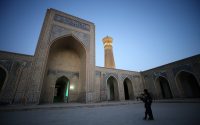Forgotten Caravaggio Portrait Goes on Public View for the First Time
A portrait attributed to Italian painter Caravaggio has gone on view in Rome, marking the first time it can be seen by the painting’s existence was made public 60 years ago.
The painting depicts Maffeo Barberini, a Florentine aristocrat who was coronated as Pope Urban VIII in 1623. By papal standards, his reign was illustrious reign. Barberini expanded the church’s territories through armed force and keen politicking, even weathering 21 years of the Thirty Years War. Urban VIII was a major patron of the arts (he often commissioned Gian Lorenzo Bernini), though the same was not true for science. Under pressure from the Vatican, Galileo publicly recanted his astronomical breakthrough, itself derived from the Copernican heliocentric model also rejected by Urban VIII.
Caravaggio met the one-day pope as a young, ambitious man. Dated to 1598, the painting shows a 30-year-old Barberini wearing a black biretta—a three or four-peaked cap worn by Catholic clergy—and a green sleeveless cassock, another traditional Catholic signifier. Bright-eyed and grasping a letter, he had already obtained a law doctorate from the University of Pisa and was ascending the clerical hierarchy through well-placed connections.
According to the gallery, Barberini had cultivated an interest in the arts early in his life. In 1598, friend and fellow clergyman Francesco Maria del Monte hosted a struggling artist at his family palazzo—a one Michelangelo Merisi da Caravaggio. Barberini was invited to meet the artist, who painted the portrait newly resurfaced from a private collection in Italy.
In a homecoming of sorts, the work is exhibited in Palazzo Barberini in Rome, which houses the National Gallery of Ancient Art. The venue was built during Urban VIII’s papacy in collaboration with architect Carlo Maderno and had remained in the Barberini family through the 20th-century. For 300 years, the Caravaggio portrait was passed down through generations of the family. Then, in the 1930s, the family sold the estate. With no documentation of its commission or purchase, and no public exhibitions, knowledge of the work faded until the 1960s, when Italian Caravaggio scholar Roberto Longhi featured it in an article.
“The heart of the painting lies in the hands, the left hand clutching a letter and the right hand emerging from the painting,” said co-curator Paola Nicita in a statement. “It is a painting that expresses itself through gestures.”



